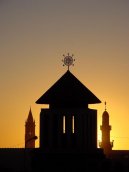Eritrea
Eritrea: Travel tips, articles, photos, gallery, cities database, population, pics, flags, statistics, free maps online
Back to Countries, Click to read the whole article: Eritrea
| Introduction - Eritrea: | | Location - Eritrea: | | People - Eritrea: | | Government - Eritrea: | | Economy - Eritrea: | Economy overview | Since independence from Ethiopia in 1993, Eritrea has faced the economic problems of a small, desperately poor country, accentuated by the recent implementation of restrictive economic policies. Eritrea has a command economy under the control of the sole political party, the Peoples Front for Democracy and Justice (PFDJ). Like the economies of many African nations, the economy is largely based on subsistence agriculture, with 80% of the population involved in farming and herding. The Ethiopian-Eritrea war in 1998-2000 severely hurt Eritreas economy. GDP growth fell to zero in 1999 and to -12.1% in 2000. The May 2000 Ethiopian offensive into northern Eritrea caused some $600 million in property damage and loss, including losses of $225 million in livestock and 55,000 homes. The attack prevented planting of crops in Eritreas most productive region, causing food production to drop by 62%. Even during the war, Eritrea developed its transportation infrastructure, asphalting new roads, improving its ports, and repairing war-damaged roads and bridges. Since the war ended, the government has maintained a firm grip on the economy, expanding the use of the military and party-owned businesses to complete Eritreas development agenda. In January 2005, the government essentially banned all imports. The government strictly controls the use of foreign currency, limiting access and availability. Few private enterprises remain in Eritrea. Eritreas economy is heavily dependent on taxes paid by members of the diaspora. Erratic rainfall and the delayed demobilization of agriculturalists from the military continue to interfere with agricultural production, and Eritreas recent harvests have not been able to meet the food needs of the country. Eritreas economic future depends upon its ability to master social problems such as illiteracy, unemployment, and low skills, and more importantly, on the governments willingness to support a true market economy. | | Gdp purchasing power parity | $4.751 billion (2006 est.) | | Gdp official exchange rate | $1.244 billion (2005 est.) | | Gdp real growth rate | 2% (2005 est.) | | Gdp per capita ppp | $1,000 (2005 est.) | | Gdp composition by sector | agriculture: 9.9%
industry: 25.4%
services: 64.6% (2006 est.) | | Labor force | NA | | Labor force by occupation | agriculture: 80%
industry and services: 20% | | Unemployment rate | NA% | | Population below poverty line | 50% (2004 est.) | | Household income or consumption by percentage share | lowest 10%: NA%
highest 10%: NA% | | Inflation rate consumer prices | 14% (2006 est.) | | Investment gross fixed | 24.5% of GDP (2006 est.) | | Budget | revenues: $257.6 million
expenditures: $424 million; including capital expenditures of $NA (2006 est.) | | Agriculture products | sorghum, lentils, vegetables, corn, cotton, tobacco, sisal; livestock, goats; fish | | Industries | food processing, beverages, clothing and textiles, light manufacturing, salt, cement | | Industrial production growth rate | NA% | | Electricity production | 276.1 million kWh (2004) | | Electricity consumption | 256.7 million kWh (2004) | | Electricity exports | 0 kWh (2004) | | Electricity imports | 0 kWh (2004) | | Oil production | 0 bbl/day (2004 est.) | | Oil consumption | 5,300 bbl/day (2004 est.) | | Oil exports | NA bbl/day | | Oil imports | NA bbl/day | | Oil proved reserves | 0 bbl | | Natural gas production | 0 cu m (2004 est.) | | Natural gas consumption | 0 cu m (2004 est.) | | Current account balance | -$440.5 million (2006 est.) | | Exports | $17.65 million f.o.b. (2006 est.) | | Exports commodities | livestock, sorghum, textiles, food, small manufactures (2000) | | Exports partners | Italy 31.4%, US 11.9%, Belarus 5.9%, France 5.1%, Germany 4.6%, Turkey 4.4%, UK 4% (2006) | | Imports | $701.8 million f.o.b. (2006 est.) | | Imports commodities | machinery, petroleum products, food, manufactured goods | | Imports partners | Italy 15.1%, France 11.8%, US 9.5%, Germany 8.6%, Taiwan 7.3%, India 7%, Ireland 6.1%, Turkey 4.4%, Jordan 4.2% (2006) | | Reserves of foreign exchange and gold | $30.6 million (2006 est.) | | Debt external | $311 million (2000 est.) | | Economic aid recipient | $77 million (1999) | | Currency code | nakfa (ERN) | | Exchange rates | nakfa (ERN) per US dollar - 15.4 (2006), 14.5 (2005), 13.788 (2004), 13.878 (2003), 13.958 (2002)
note: the official exchange rate is 15 nakfa to the dollar | |
| Communications - Eritrea: | | Transportation - Eritrea: | | Military - Eritrea: |
This page was last updated on 16 September, 2007
Source: CIA >>> |




